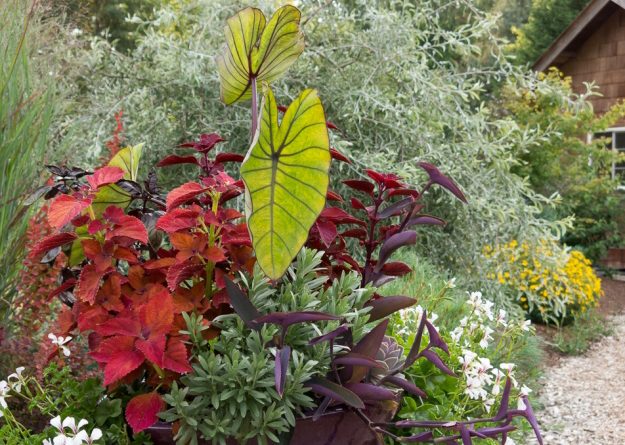July 29, 2017 – Fun with Foliage
![]() Imagine that you write a book about plants that focuses on their foliage. Let’s call it…oh, say, Fine Foliage, and let’s imagine that you get a wonderful photographer like Ashley DeLatour to fill the book with images, and let’s say that people like accomplished author Debra Prinzing write things like
Imagine that you write a book about plants that focuses on their foliage. Let’s call it…oh, say, Fine Foliage, and let’s imagine that you get a wonderful photographer like Ashley DeLatour to fill the book with images, and let’s say that people like accomplished author Debra Prinzing write things like
Fine Foliage is a visual treat that will inspire you with dazzling combinations for containers and gardens. Karen Chapman and Christina Salwitz explain why each combination works – bringing artistic design within easy reach of all gardeners. A great user-friendly resource.
And then let’s say that, lo and behold, the book scoops up a prestigious Garden Writers Association GOLD Medal for best gardening product published in 2013.
Now what?
Well, if you are the aforementioned Karen Chapman and Christina Salwitz, you brand yourselves with the name “Fine Foliage,” pack up the truck and hit the road in search of even more fine foliage that you can put into a second book. This time, you call it Gardening with Foliage: 127 dazzling combinations that pair the beauty of leaves with flowers, bark, berries, and more.
I guess now they sit back and wait for their second GWA Gold Medal. Or they get on a radio show in Chicago and talk about how the average homeowner can stop obsessing over blooms and still have a stunning garden. They write,
If you focus on the flowers with considering the foliage, you may end up with a disappointing mélange of midsize green leaves for much of the year, not a unified, well-designed look.
Which makes me wonder how they got hold of photos from my garden. But I digress.
Chapman and Salwitz have divided the book into two main growing seasons: Spring and Summer, and Fall and Winter, each of which is subdivided into sections for growing in sun and shade. And since they’re creating year-round interest, their plant palette runs the gamut of annuals, perennials, herbaceous perennials, deciduous, semi-evergreen, evergreen, and even vegetables, which often serve very nicely as ornamentals.
Most of their designs consist of about three different kinds of plants that either complement or challenge each other–sometimes both. And you can tell that they must have enjoyed brainstorming the names of their designs, coming up with monikers like Bad Hair Day, Calculated Risk, Naughty But Nice, Purple Passion, Shadows and Silhouettes, Abstract Art, Lemon Drop Martini, Jurassic Moment, The Ticklish Porcupine, Pumpkin Spice Latte and more.
Oh, and did I mention that they took many of the many inviting photos themselves? That seems to be the trend these days (which makes my brother the photographer not so happy), and they handle it with aplomb.
One of the things that has made their collaborations possible is that they live within shouting distance of each other just outside of Seattle, Washington. Karen Chapman was born in England, moved to the Pacific Northwest in 1996 and after a decade of working in a nursery, started her own business, Le jardinet in order to, as she says, “provide a service that takes all the time, stress and guesswork out of the design process for you.”
Christina Salwitz describes herself as a horticultural guidance counselor, and Horticultural Photojournalist in Renton, Washington, whose business is called The Personal Garden Coach. She features organic methods, improving soil quality, pruning technique and seasonal focus in teaching folks how to create their own bit of paradise.


